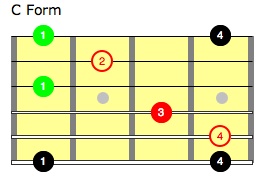Moving The C major Arpeggio Form
After you have gotten comfortable with your C major form arpeggio, the next step is to understand how to move it to different keys.
Here is your C form arpeggio again with the common C chord shape in red and green highlights:
The key to moving the C form to different keys is simple to put the root notes ( circled #’s) on the key that you want. Their are two root notes in this form, either will work.
Lets try putting the C form arpeggio in the Key of G:
- Pick a root note in the C form arpeggio. Lets use the one on the Low A string played with the 4th finger.
- Now locate the G on the Low A string of your guitar or fretboard diagram below. You should have found it at the 10th fret on the Low A string.
- Now place your pinky on that note and proceed to playing your C form arpeggio. You have now successfully moved this arpeggio form to the key of G.
Here is a map of the fret board for reference:
Lets try one more in the Key of D:
- Lets use the other root note this time. Its on the B string and is played with the 2nd finger.
- Locate D on the B string. Its on the 3rd fret of the B string. You may have also found it at the 15th fret of the B string as well. Either will work but lets keep it down low.
- Put your 2nd finger on the D note that you found and play your C form shape as you always have. You have now succeeded at putting this form in the key of D
Important things to remember:
- C form is a shape not a key. Don’t confuse this shape as being in the key of C. It is called C form because it comes from the common C chord shape. It can be moved to be in any of the 12 keys available to us in Western music.
- Know where your root notes are. This is essential in being able to move it to other keys.
- The notes come from the C form Major Pentatonic Scale. This arpeggio and that scale go hand in hand.
Previous Lesson: C Major Arpeggio Form
Next Lesson: A Major Arpeggio Form
 Copyright secured by Digiprove © 2014 jeff lauffer
Copyright secured by Digiprove © 2014 jeff lauffer 




Leave a Reply